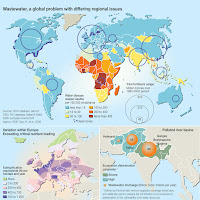- Water Resources
- The Earth's total volume of water is 1.4 billion km3.
- A world of salt: Only 2.5% of which is freshwater (35 million km3).
- Of those 2.5% of freshwater, 68.9% is in the form of ice, 30.8% is in the soil and only 0.3% is in rivers/lakes.
- The total supply of usable freshwater for humans and natural ecosystems is approximately 200,000 km3, less than 1% of all freshwater, and less than 0.25% of all water on Earth.
- 13,000 km3 of freshwater are located in the Earth's atmosphere, in clouds or ambient humidity.
- Water Use
- How the world uses freshwater:
-about 70 percent for irrigation
-about 22 percent for industry
-about 8 percent for domestic use - The use of water has been increasing twice as fast as the human population in the last century.
- The world's six billion people are appropriating 54 percent of all the accessible freshwater contained in rivers, lakes and underground aquifers.
- 145 nations have territory within a transboundary basin.
- Water withdrawals are predicted to increase by 50% by 2025 in developing countries, and 18% in developed countries.
- Over 1.4 billion people currently live in river basins where the use of water exceeds minimum recharge levels, leading to the desiccation of rivers and depletion of groundwater.
- In 60 percent of European cities with more than 100,000 people, groundwater is being used at a faster rate than it can be replenished.
- By 2025, 1 800 million people will be living in countries or regions with absolute water scarcity, and two-thirds of the world population could be under stress conditions.
Why care about water
- Drinking water and Sanitation
- The UN suggests that each person needs 20-50 litres of safe freshwater a day to ensure their basic needs for drinking, cooking and cleaning.
- More than one in six people worldwide - 894 million - don't have access to this amount of safe freshwater.
- Globally, diarrhoea is the leading cause of illness and death, and 88 per cent of diarrhoeal deaths are due to a lack of access to sanitation facilities, together with inadequate availability of water for hygiene and unsafe drinking water.
- Today 2.5 billion people, including almost one billion children, live without even basic sanitation. Every 20 seconds, a child dies as a result of poor sanitation. That's 1.5 million preventable deaths each year.
- In Sub-Saharan Africa, treating diarrhoea consumes 12 percent of the health budget. On a typical day, more than half the hospital beds in are occupied by patients suffering from faecal-related disease.
- Washing hands with soap can reduce the risk of diarrhoeal diseases by up to 47 per cent.
- The first ever global handwashing day was celebrated on 15 October during the International Year of Sanitation.
- Water waste
- Every day, 2 million tons of human waste are disposed of in water courses.
- In developing countries, 70 percent of industrial wastes are dumped untreated into waters where they pollute the usable water supply.
- Contribution of the food sector to the production of organic water pollutants:
- High income countries: 40 percent
- Low-income countries: 54 percent - Projected increases in fertilizer use for food production and in wastewater effluents over the next three decades suggest there will be a 10-20 per cent global increase in river nitrogen flows to coastal ecosystems.
- Half of the world's wetlands have been lost since 1900.
- Between 1991 and 2000 over 665,000 people died in 2,557 natural disasters of which 90 percent were water-related events.
- Water and Agriculture
- The daily drinking water requirement per person is 2-4 litres, but it takes 2 000 to 5 000 litres of water to produce one person's daily food.
- It takes 1 000-3 000 litres of water to produce just one kilo of rice and 13 000 to 15 000 litres to produce one kilo of grain-fed beef.
- In 2007, the estimated number of undernourished people worldwide was 923 million.
- Over the period to 2050 the world's water will have to support the agricultural systems that will feed and create livelihoods for an additional 2.7 billion people.
- The extent of land under irrigation in the world is 277 million hectares, about 20 percent of all cropland. Rainfed agriculture is practiced on the reamining 80 percent of the arable land.
- The Intergovernmental Panel on Climate Change predicts yields from rain-dependent agriculture could be down by 50 percent by 2020.
- Due to climate change, Himalayan snow and ice, which provide vast amounts of water for agriculture in Asia, are expected to decline by 20 percent by 2030.
- Irrigation increases yields of most crops by 100 to 400 percent, and irrigated agriculture currently contributes to 40 percent of the world's food production.
- Poor drainage and irrigation practices have led to waterlogging and salinization of approximately 10 percent of the world's irrigated lands.
If you want to learn more about global water issues, you can read the following ebook entitled "Sick Water?" published by UN Water.
Lastly, below is an interactive map for you to play around.
Sources:
UN Water
United Nations Environment Programme (UNEP) / GRID-Arendal







